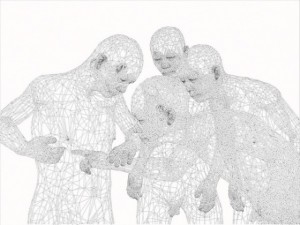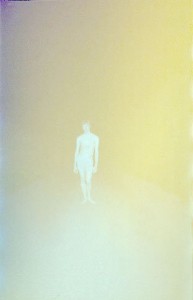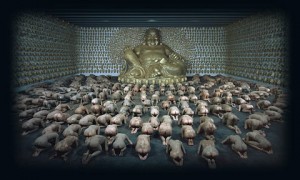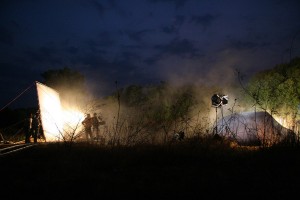I would like to answer simply: a thousand plateaus. Small huddles of the converted in cities around the world, dedicated to a different kind of seeing and hearing. Is this so different, I wonder, from ten years ago or fifty?
I am carrying on a great infatuation with computer generated music: the hum of hallways, the drone of contact microphones placed inside steel drums, these are my favorite company. And imagine this: no matter how obscure the release, I am able to find information, track listings, reviews (!), and informed opinions on the web, and more than that, owing to the magic of peer-to-peer file sharing, I can swap my finds with others. There are some, I could name a few, who are similarly bit torrenting fringe media, but their numbers are small, the downloads take forever, and the quality is worse than sketches. In this moment when the digital world is overtaking its analog parent, fringe media is well behind. Little surprise perhaps. This will change of course, we are moving towards a place of perfect transparency, where everything will be, can be, must be made available. The digital world is possessed of a will to transparency and availability, which functions independently of its operators. Perhaps the interests of globalization will stem the tide, but even in the backwaters of the fringe one can imagine these effects will be profound.
Three aspects to consider then: production, distribution, exhibition. The old model insists that artists accompany their work, screen it and explain it, and then vanish. The updated version sees the same work celebrated in gallery exhibitions, where it can be ignored at openings, loop into the minds of lonely gallery staff, and then be taken down and replaced by braver newer worlds. A visible invisibility (it is always showing, but no one sees it) has replaced the former invisible visibility (screenings which no one attends). Sofar as the non-business of distribution is concerned, most distributors are warehouses of unmoving stock, like Duchamp’s construction of The Large Glass, they are busy gathering dust for their artist clients. On the other hand there is a steady trickle of viewings, far from the clamour of award shows and reality posings, where fresh eyes can be impaled on the whims of this year’s model. Or last year’s canonized moment.
And the artists? There are more fringe media-nauts working today than ever before, and their strange, singular, beautiful markings are more important than ever. How else to make a stand against globalized pictures? Well, there are plenty of ways, but here is a sustained response, a naysaying which is, at the same time, an affirmation. How many times have I thrilled to the wit of Steve Reinke (here is one artist that doesn’t need a laugh track), the Lebanese missives of Jayce Salloum, the sublime self flagellations of Deirdre Logue, the lived stolen footage of Aleesa Cohene, the cinemascope home movies of John Price (yes, that’s right, it’s his boy’s third birthday party, and those are his three year old friends eating cake and laughing and living, and it’s all happening in 35mm wide screen, larger than life). Of course it hurts that there is no online micro-cinema review journal (not even The Wire), or get-together salons where people could speak frankly about work. In its place there is the dog and pony show of post-screening talks, off hand ripostes at the bar. Most distribution is left to the artist, and because there are no standards, masterpieces are shown along with truly dreadful shit and often folks can’t tell the difference. I have spent part of my summer transcribing Stan Brakhage talks at the Millennium Film Theatre in New York, and at each screening, without fail, there is someone who asks a question who has never been exposed to the field before (and behind the questioner how many more, who dare not raise a hand?) Imagine reading poetry to people who had never encountered a poem before. Then imagine you have been writing poetry all your life. The gap between this writing and its reception seems so terribly large. But I am not haunting modern dance breakthroughs or poetry evenings either. Faced with the time bomb of the home computer, who has time for time-based media?
Soon the era of flat (two-dimensional) movies will come to an end, along with one-way experiences like books, and this work may be understood as a footnote to a brief and popular phenomena known as the movies. Moving pictures, can you imagine? As faraway as radio plays or rock painting.
Until then there is only time to lose and we will delight in losing it. We will arrive with our cameras and wait for the good light. Dish an unbearable confession. We will dare to complicate our complications, and to simplify our simplicities. Failure only makes us stronger. We are bound to no credo, no corporation, no logo, no dreams of profitable advance. Our ambitions are as large as our means are modest. What is the situation today? No stopping that’s all.
August 20, 2007






